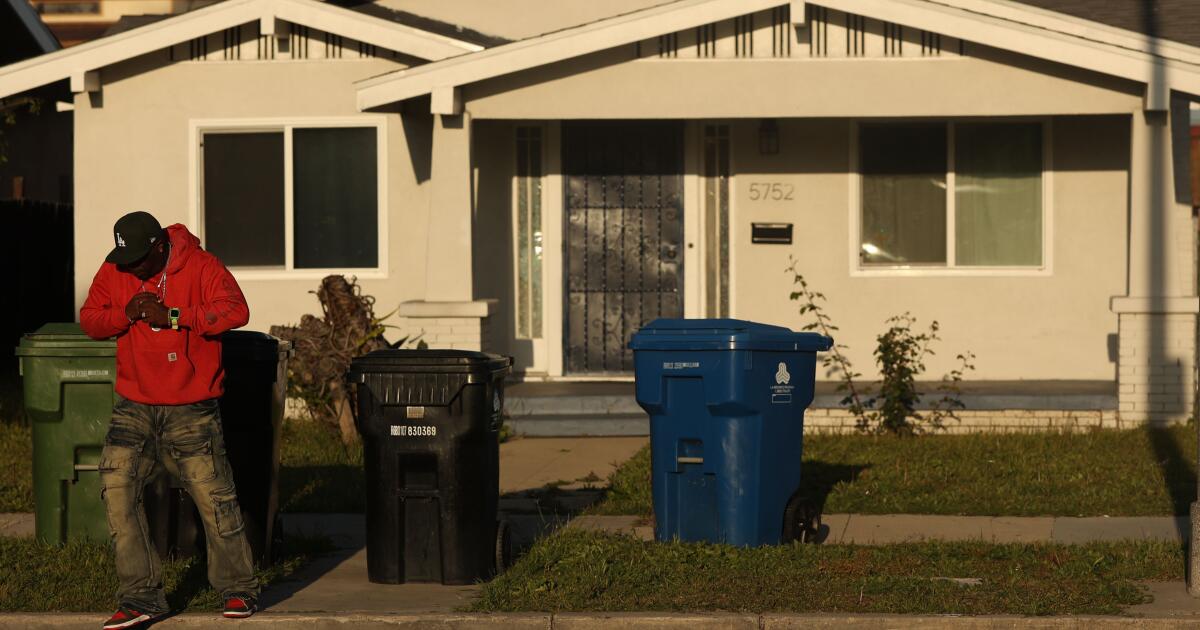Trash fees will spike for many L.A. residents after fiscal crisis
Many Los Angeles residents will soon be paying significantly more for trash collection after the City Council voted Tuesday to finalize a dramatic fee increase.
The trash program had become heavily subsidized, to the tune of about $500,000 a day, which officials said was no longer viable given the city’s dire financial straits, which left them scrambling to close a nearly $1-billion budget deficit earlier this year.
Having the cost subsidized by the city for so long contributed to that deficit, according to City Administrative Officer Matt Szabo.
“It should have been corrected a long time ago,” Szabo said. “If we didn’t get this rate increase, the subsidy would have been more than $200 million this year.”
The city hadn’t raised trash pickup fees in 17 years, and a 2016 state law governing organic waste disposal significantly increased operational costs. Large raises for city sanitation workers and rising equipment costs also bumped up expenditures.
Once the new fees go into effect, probably in mid-November, residents of single-family homes or apartments with four units or less will pay $55.95 a month per unit.
That sum is more than double the $24.33 a month that occupants of triplexes and fourplexes had been paying, and a roughly 50% increase on the $36.32 previously paid by residents of single-family homes and duplexes.
Those customers put their waste in black bins for regular trash, blue bins for recycling and green bins for organic waste, which are emptied by city workers once a week. Larger apartment buildings will be unaffected by the changes, because their waste collection is administered through a separate program.
The fees will increase by an additional $10 over the next four years.
By next year, the increased fees will reflect the actual cost of trash pickup and will be on par with or slightly below what residents pay in nearby cities such as Long Beach, Pasadena, Culver City and Glendale.
Still, the new fees will almost certainly engender sticker shock for L.A. residents already contending with skyrocketing insurance premiums, rising rents and eye-popping grocery prices. Rates will be reduced for low-income customers who qualify for the city’s EZ-SAVE or Lifeline programs.
The City Council approved the increase on a 12-2 vote, with Councilmembers Monica Rodriguez and Adrin Nazarian dissenting.
Last week, the council also voted to raise the prices and hours of city parking meters.
“After approving a $2.6-billion Convention Center expansion, the council is asking residents to pay more for basic services like trash collection while delivering less. That doesn’t reflect the priorities of working Angelenos,” Rodriguez said after Tuesday’s vote. “I can’t, in good conscience, support that approach.”
A number of factors catalyzed the city’s financial issues, which exploded into public view during the budget process earlier this year. Los Angeles had taken in weaker than expected tax revenues, paid out more in legal liabilities and adopted large-scale raises for city employees.
When Mayor Karen Bass first presented her budget in the spring, layoffs for more than 1,600 city workers were on the table. She and the City Council were ultimately able to avoid those cuts through a number of cost-saving measures.
Tuesday’s final vote on the trash fees came nearly six months after the council gave preliminary approval to the plan.
The matter was complicated by Proposition 218, a 1996 statewide ballot measure designed to make it harder for local governments to raise taxes and fees. To satisfy the proposition’s requirements, the city had to hold public hearings and give every affected resident the opportunity to weigh in via a notice mailed to their homes before the increase could move forward.
The fee hike legislation still has to be signed by the mayor and formally published by the city clerk. The fee can’t go into effect until 31 days after that, or mid-November at the earliest.
The city budget, however, was calculated under the assumption that the new fees would go into effect Oct. 1. The delay will leave the city on the hook for an extra $500,000 a day.
Because Tuesday’s vote was not unanimous, the ordinance will receive a second reading next week before the council formally approves it and sends it to the mayor — a technicality that will cost the city $3.5 million. The mayor plans to sign it as soon as she receives it, her office said.
The delay to mid-November will cost the city a total of at least $22 million, creating another deficit that will have to be adjusted for down the line.
Still, some residents decried the ballooning fees, with one calling the increase “preposterous.”
“Listen to our cries,” the person, who did not give their name,said in a written public comment. “We can barely keep a roof over our heads — at this time! Los Angeles is falling apart. It is your job to fix it more practically.”
The Historic Highland Park Neighborhood Council also opposed the rate hike, arguing that residents are already facing steep cost-of-living increases and that layering more fees on top of that would be “neither fair nor sustainable.”
The last time the city increased trash fees, back in the summer of 2008, City Controller Kenneth Mejia was a few months out of high school, George W. Bush was in the Oval Office and Katy Perry’s “I Kissed a Girl” was topping the Billboard charts.
Amid a global economic downturn, the city was facing widespread cuts, and leaders looked — as they often do — to the price tag of city services to try to balance the budget.
Times staff writers David Zahniser and Dakota Smith contributed to this report.







